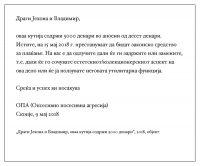The relation between art and work, earnings, profit, then the corporate role, sponsorship and a number of other issues related to the production cycle, the physical and intellectual work and the time invested in works of art, actions, gestures have been considered in various forms. However, it is often also as an activity that is outside of the economy, an expression of free will and freely established relations of exchange, friendship or simply a gift.
Marcel Duchamp, who is considered one of the most important artists of the 20th century, is especially fascinating with his unpretentious gestures. Some of his key works are motivated by his relations with friends, supporters and dedicated observers. His work titled 50 cubic centimeters of Paris Air (Paris Air), 1919, a glass ampoule containing air from Paris, was brought by Duchamp to New York in 1920 and given to Walter Arensberg as a gift.[4] Another interesting example is the object descriptively titled For Seating Only, which Duchamp made as a gift for his friends Julien and Jean Levy at their wedding ceremony on January 20, 1957 in Bridgewater, Connecticut. This work, largely unknown, is a toilet seat with seven falsies with nipples colored in pink, glued, leaving space for sitting. The same ones that were used together with Enrico Donati for the luxurious edition of Le Surréalisme en 1947.[5]
Duchamp’s good friend, Man Ray, has also created some of his most recognizable works as a gift. The “Gift” (1921) is one of his earliest readymade works consisting of 14 thumbtacks glued on its base, made in 1921 on the day of his first solo exhibition in Paris. Although not included in the catalog of paintings, aerographs and collages, he added this work to the exhibition, as a gift to the gallery owner, the poet Philippe Soupault.[6]
The gift is usually regarded as an object that someone gives to another without expectation of compensation or reciprocal return, and the concept of the gift is considered by many anthropologists and culturologists as one of the important steps for developing interpersonal and social relations.[7] A particularly interesting phenomenon is the gift in a monetary form, that is, the famously universal and often expected “wedding gift in an envelope”, and even more so, when in some cases it becomes a subject of taxation.
4. The original was broken and was replaced by Duchamp in 1949.
5. Reproduced for the first time with a short description of the work in: Jennifer Gough-Cooper and Jacques Caumont, “Ephemerides,” n. pag. [20 January 1957].
6. As noted, due to the intriguing connection, the work drew attention and disappeared the same day, and one of the replicas made in 1958 is kept at the Museum of Modern Art in New York. Man Ray, Gift (Cadeau), 1921/1958, Painted flatiron, 15 cm x 9 cm x 11 cm, MoMA.
7. One of the classic works is that of Marcel Mauss who concluded that in modern market economies, the social policies and concepts such is the welfare state are based on some aspects of the morality of the gift in the archaic communities. Marcel Mauss, The Gift: The Form and Reason for Exchange in Archaic Societies (London and New York: Routledge, 2002). On the paradoxes of the gift in contemporary theory see: Olli Pyyhtinen, The Gift and its Paradoxes: Beyond Mauss (Ashgate, 2014).







